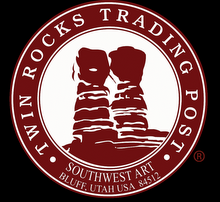Late in the afternoon on the type of October day that makes visitors to the trading post ask questions, like, "Is it always this nice here," I stood behind the counter, watching the day fade. Of course, nothing is ever always the same, and in Bluff everything, including the weather, can change on a moment's notice.
These late autumn days make me long to capture a few of them to remind me of fall during the heat of summer or the chill of winter. On this particular afternoon, the golden sunlight streamed through yellow cottonwood leaves and splashed on the ground, creating pools of gold that are worth more to me than any precious metal. The beauty of that light makes my heart beat slower, easier, and at times causes me to feel I am moving in an almost hypnotic state.
As the sunlight dimmed, the smell of some exotic melon began to permeate the store, and I could see people unsuccessfully attempting to identify the aroma as they entered through the Kokopelli doors. A young man in his early twenties strolled in, sporting waist length hair imprisoned by a series of rubber bands and an Australian accent that seemed too forced to be real. "Do you have any knee-high moccasins and bone chokers," he asked. "No, sorry," I answered in a voice so casual that I may have inadvertently notified him that this was not your average knee-high moccasin and bone choker kind of place.
An elderly female couple wandered through, smiling, pointing and complimenting in an extremely friendly fashion. Their senses also worked hard to identify the scent of the melon hidden behind the counter. The melon, along with some blue corn cookies and several chilies had been left with me by Ray Lovato only an hour before. "Grown from my own patch," he proudly declared as he handed over the chilies.
Without telling me the specific variety, Ray had informed me the melon was a highly effective means of attracting the opposite sex. He said one must only eat its fruit and boil the left over rind, placing a little alcohol in the boiling water to enhance the fragrance. Once the rind was completely rendered, he said I should rub it on my face, chest and well, the rest cannot be mentioned in polite company. It was guaranteed to work, he assured me. His teenage daughter blushed and turned away.
After Ray exited the store, a mining economist who had been educating me about existing and extinct turquoise mines; the formation process associated with turquoise, verascite, azurite and malachite; and the production, or lack thereof, of mining regions in Colorado, New Mexico, Arizona and Nevada, asked, "Has he been drinking?" "No," I explained, "That is just Ray¹s love of the fairer sex on display. Ray gave up drinking decades ago. Now he is addicted to turquoise and memories of his past exploits; maybe even some future adventures if his melon potion works."
The question posed by the economist reminded me just how difficult it is for visitors of this area to understand the local cultures. It also reminded me of a few days ago when two women came striding into the store. "Are you here for the Bluff Arts Festival," I asked. I tried to speak slowly and deliberately, so the name of the event would not sound flatulent. "Yes," they responded. "We were out at the mission for the Spin Off, but there was a live sheep when we arrived that was not alive when we left," they explained with undisguised disgust. The women failed to understand that, on the Navajo Reservation, sheep are considered a gift to the people; an expendable and readily consumable resource.
Later that same evening, Kira'¹s friend, Gabby and I were discussing the slaughter of sheep, when Kira announced that killing sheep was "disgusting." Gabby patiently explained to Kira and Grange how the process was to be managed and described all the delicacies that can be created with sheep intestines, brains and blood. To Gabby, butchering animals for food was as natural as taking ground beef from the freezer. To Kira, the procedure was still foreign, even though she had seen it done in the past.
In our modern world of prepackaged everything, we have moved away from the basic processes of living. Many of our Native American friends, however, still remember. Ray, on the other hand, must have had a memory lapse, because his recipe for love was a complete failure.
Sincerely,
Steve
 |
|







